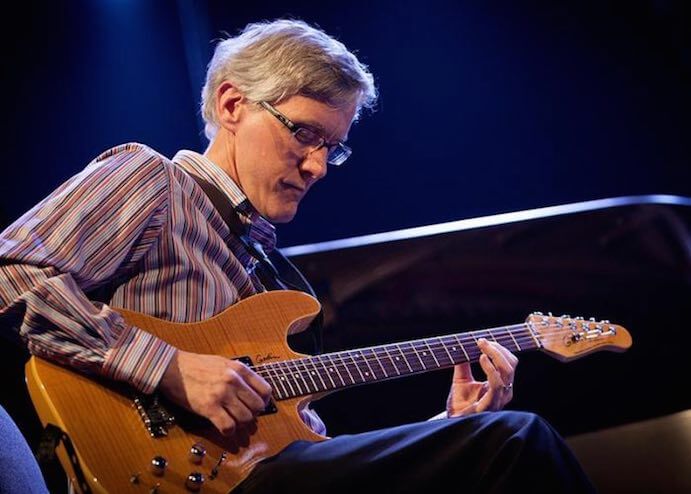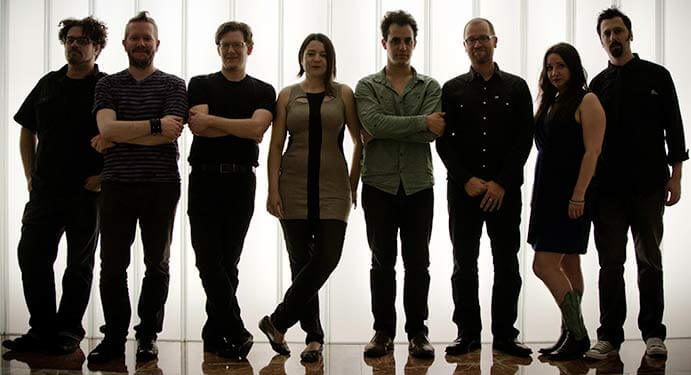It’s a dramatic moment when the doors open at National Sawdust. After standing in a slim black lobby, concertgoers are invited to enter by the light of the performance space that is part cathedral, part spaceship, and part spelunking expedition. Its dramatic design and warm acoustics were the perfect setting for Canadian Tim Brady’s Atacama: Symphony #3, given its American premiere by 16 Trinity Wall Street choristers and 11 Newspeak ensemble instrumentalists on Thursday, October 29, 2015. The sound byte of classic electric guitar solos seemed to serve as Brady’s primal inspiration, as did the writings of Elias Letelier and the passion of Chilean politics. He funneled their adrenaline and virtuosity through traditional orchestration and jazz to create music neither hybrid nor patchwork. Instead, his work offers one way forward for postmodern, postminimal new music by wrapping endless influences with wiry self-control and mature emotion.
Brady tried to begin Thursday’s program unnoticed, but the audience applauded as soon as he appeared through the side door. “Ok, we can take the traditional approach,” he conceded before letting out a blare on the electric guitar. The Same River Twice: Symphony #5.SOLO, a solo for electric guitar in three movements, elevated the instrument to a broader, patient landscape while preserving its fierce dramatic energy. The piece’s three movements were a beautiful showcase of National Sawdust’s acoustic capabilities as Brady piloted the electric guitar through crests of sound in “Freeze,” “Thaw,” and “Burn.” He eventually manipulated the guitar to imitate an organ, and the acoustics rolled with pepper majesty. At another point, a simple Bossa Nova rhythm lilted common sense before bursting into an electric guitar solo, spitting out melodic fragments that were quickly buried in distortion. It could be argued that the most virtuosic element of the performance was Brady’s footwork. Often busier than his fingers, his feet worked 10 pedals in front of him to loop, layer, and distort the electric guitar. In fact, effects pedals were listed alongside electric guitar as instruments of the piece. The constant clicking of the pedals– most frequently in pauses where the sounds were dying– was a constant percussion and a singular contribution to the piece.

Tim Brady
After The Same River Twice: Symphony #5.SOLO, there was only a brief pause to allow the choristers and instrumentalists to take the stage for Atacama: Symphony #3. The first of its six movements featured the choir only and expanded its capabilities like an accordion. Once the instrumentalists joined, however, Brady utilized the choir as one instrument, condensing its power, highlighting its tone, and pinging different parts to display tonal unity rather than harmonic complexity. The choir’s presence was shaped around extracts from Elias Letelier’s book Symphony, and the Trinity Wall Street choristers finessed every facet of their performance: warm Spanish, unified vowels, and impeccable diction. One monastic, straight-toned solo contrasted trendy, lengthy dissonant chords. A moment of soprano unison was breathtaking.
Newspeak peeled into Movement II with crisp, understated percussion by Peter Wise and flawless sync between winds and strings. The ensemble never faltered in energy, control, or unison: on top of its game and enjoying itself, too. Kris Saebo grooved on bass and so did the audience. Feet tapped and smiles appeared. The orchestration had rhythms and instruments of jazz– nodding to Brady’s background in free improvisation and modern dance collaborations– but it was just barely not jazz. Excepting the electric guitar, each instrument was fully equal and without a dedicated solo; the choir was a strong classical operatic element; and the almost-groove was suspended inches off the ground. One moment– 4 perfect beats of pregnant total silence– caught the audience’s breath with glee.

Newspeak – Photo by Stephen Taylor
Like Brady’s guitar solo, the symphony was propelled by rhythm. The piece picked up its own speed and barrelled toward the sudden drop of a virtuosic guitar solo, played by the valiant Taylor Levine. The drastic, albeit tangential, solo was one blunt way to solve the piece’s lack of friction; it slowed the momentum enough for Brady to guide the final movements to a halt. By widening his means of expression through the choir’s dramatic capabilities and extended instrumental techniques, he was able to control the rhythmic flow and close out the piece. Its climax felt misplaced– too soon at the end of a piece slightly too long– but it was satisfying nonetheless. If the symphony sounds rambunctious and sprawling, however, it is not. The piece’s motion and emotion is radiantly self-mastered without angry edges or sharp corners. Over the course of the symphony, Gregorian chant, trendy Whitacre choral sounds, jazz, rock ‘n roll, and classical orchestra were all utilized as influences, but the final sound was all its own. Brady’s work is deeply emotive, grounded, and elegant.
National Sawdust was an impeccable host to Brady’s vast electroacoustic sounds. Constructed as a soundproof box-within-a-box, the venue vibrated and almost bounced on its supporting springs. The space is surprisingly small– this performance sat less than 50 people– but the building is more than acoustically functional. With its single-row balcony breaking into the white backlit walls; black lines of every angle and width slicing up the wall panels; and one corner that bubbles out like a small geode, the venue contributed its own energy to the program. Brady’s music engages more than the intellect, and he needed a venue that could house the passion of his work. His music rolls its pluralistic elements inside demanding technique, and evolves its pistol-sharp rhythms into hope.























